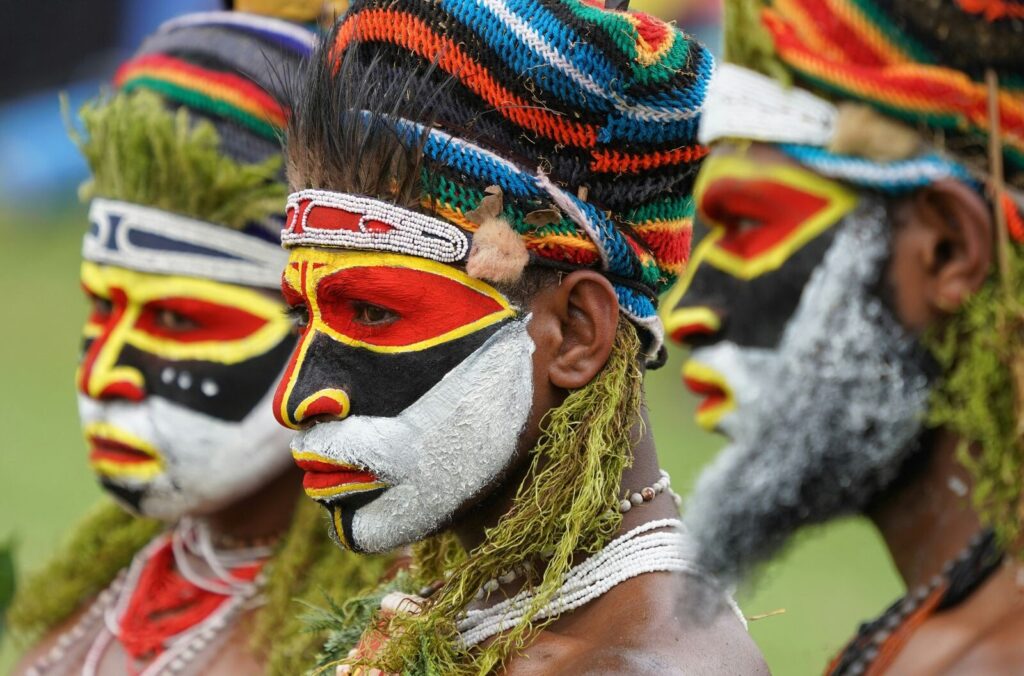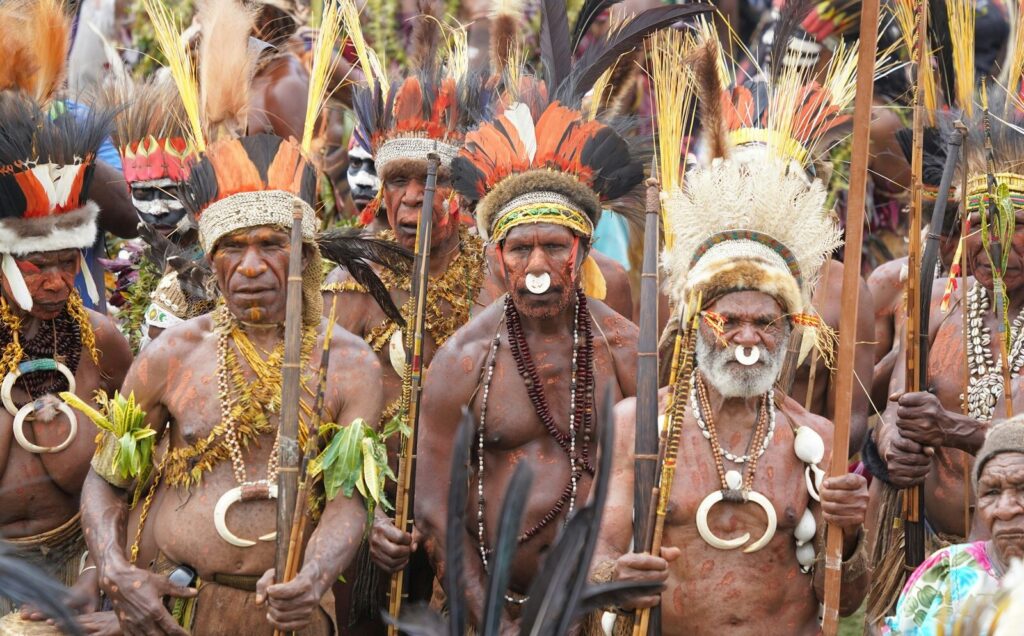Cooperating Volunteers has been offering international volunteering experiences for years—a purposeful journey that allows us to be part of positive change in many communities and also discover ways of life completely different from our own.
Today, we want to share a curiosity with you: in such a globalized and connected world, there are still some unexplored peoples, tribes, or communities that live in total connection with nature.

Did you know that there are around 5,000 indigenous tribes in the world?
These communities make up more than 470 million people and are spread across 90 countries, representing 6% of the global population.
They are located in the Amazon (Brazil, Peru, Colombia, Ecuador, Bolivia, and Venezuela), New Guinea (Indonesia and Papua New Guinea), Indian Ocean Islands, and Central Africa (isolated peoples in Congo and Angola).
Many of these tribes are endangered due to deforestation, mining, illegal hunting, and external diseases. These tribes have avoided or rejected contact with the outside world, and in some cases, their existence is only known through aerial sightings or traces left in the jungle.
We will talk about some of them, and the information that is available.
– SENTINELESE (India)
They inhabit North Sentinel Island, in the Andaman and Nicobar archipelago, India.
It is believed they have lived there for over 60,000 years without contact with the outside world.
The estimated population is between 50 and 200 people, although there are no exact data. Their language is completely unknown as it bears no relation to any other. They are hunter-gatherers and do not practice agriculture or livestock farming. They use spears, bows and arrows, and other rudimentary tools, and live in small huts scattered across the island. They have dark skin, curly hair, and are of short stature.
They are extremely hostile to outsiders and have attacked those attempting to approach the island with arrows. In 1974, they shot arrows at a National Geographic team; in 2006, they killed two fishermen who entered their territory; and in 2018, they killed American missionary John Allen Chau, who tried to evangelize them.
To protect them, the Indian government has banned access to the island, as contact with the outside world could be fatal to them due to a lack of immunity to common diseases. The tribe remains isolated, and it is illegal to approach within 5 km of the island.
Knowledge about the Sentineleses comes from aerial sightings and brief attempts at contact in the past. However, there are no detailed studies on their culture, religion, or social structure.
They are one of the last truly primitive and independent societies in the world.
– HULI WIGMEN (Papua New Guinea)
They are one of the most fascinating tribes of Papua New Guinea, known for their spectacular human hair wigs and yellow, red, and white face paint. They are an indigenous group that has maintained many of their ancestral traditions, despite contact with the modern world.
Their estimated population is 150,000 people, located in the Southern Highlands of Papua New Guinea, in Hela Province. They speak Huli, although some also know Tok Pisin or English. They are hunters, farmers (they grow sweet potatoes, bananas, and taro, and raise pigs, which are symbols of wealth and used in trade and ceremonies), and warriors. They have animist beliefs, with great respect for nature spirits and ancestors.
One of their most surprising traditions is the making of ceremonial wigs from their own hair. Young Huli who want to become warriors isolate themselves for months in “men’s houses” and follow a strict diet. During this time, they regularly shave their heads and use the hair to weave their wigs. Once completed, the wigs are decorated with bird of paradise feathers, leaves, and other ornaments.
The Huli have a long tradition of tribal conflict, which used to be resolved with armed clashes. Although wars are less common today, disputes still occur, often over territory, resources, or revenge.
Their war attire includes: bodies painted with clay, wigs and bird of paradise feathers, and spears and bows.
Although many Huli maintain their traditions, others have adopted modern customs. They live in towns like Tari and work in tourism or mining. However, they still preserve their traditional rites, dances, and ceremonies.
– AWÁ (Brazil)
Also known as Guajá, they are one of the most threatened tribes of the Brazilian Amazon. They are nomadic hunter-gatherers, and some of them still live in complete isolation, avoiding contact with the outside world.
They live in the state of Maranhão, Brazil, in the Amazon rainforest. Their estimated population is about 600 people, of which around 100 remain uncontacted. They speak Awá-Gujá, from the Tupi-Guarani language family. They move constantly through the jungle, hence being considered nomadic; they hunt monkeys, tapirs, and birds with bows and arrows. Some cultivate cassava, corn, and bananas. They also raise wild animals as pets, especially orphaned monkeys.
The Awá are considered one of the most endangered peoples in the world, mainly due to deforestation (illegal loggers have destroyed large parts of their territory), mining and cattle ranching (the advance of livestock and mining companies invades their home), violence (settlers and loggers have attacked the Awá, even killing some), and disease risk (they are highly vulnerable to common illnesses like the flu).
In 2012, a campaign by Survival International pressured the Brazilian government to expel illegal loggers from their territory, but the problem persists.
Uncontacted Awá groups are completely self-sufficient, live naked or with minimal clothing made from natural fibers, build temporary huts with palm leaves, and have deep knowledge of the jungle, being able to survive on what they find.
Experts fear that if uncontacted Awá are forced out of the jungle, they could quickly disappear due to disease and loss of territory. For this reason, the Brazilian government has demarcated some protected lands, but surveillance is weak. Indigenous organizations and NGOs continue to fight to defend the Awá from the destruction of their home.

– KOROWAI (Indonesia)
They are an indigenous tribe from West Papua (Indonesia), known worldwide for their unique lifestyle and especially for their treehouses built over 20 meters high. For a long time, they were considered a “lost” tribe and had no contact with the outside world until the 1970s.
They are located in the tropical rainforest of southeastern Papua, near the Becking River. Their estimated population is about 3,000–4,000 people. They speak Korowai, a Papuan language unrelated to other known ones. They are farmers, cultivating sago, bananas, and papayas, and also hunters of wild pigs, rats, and birds using spears, bows, and traps. Building treehouses serves as protection from evil spirits, floods, and enemies.
The Korowai build houses more than 20 meters high (some up to 35 m) with sago palm wood and woven leaves, with a single open space where the whole family sleeps. They access them via bamboo ladders.
For years, it was claimed that the Korowai practiced ritual cannibalism, especially as punishment against witches or “khakhua” accused of black magic. Some sources state this was real but has almost completely disappeared. Others argue that much of this narrative was exaggerated by explorers and media to attract attention. Today, it is a highly debated topic among anthropologists, and the Korowai themselves often speak of it ambiguously, especially in front of outsiders.
Some Korowai have adopted modern elements: clothing, metal tools, or even cellphones in certain villages. Tourism has grown, with visitors paying to see their way of life, leading to a blend of tradition and spectacle. Still, many Korowai groups continue to live traditionally in remote areas of the jungle.
– CHULYM (Russia)
They are an indigenous group mainly living in southwestern Siberia, Russia, along the Chulym River. They are part of the Tungusic peoples and have a history dating back thousands of years, although in recent times their culture has been in serious danger due to globalization and assimilation.
They mainly inhabit the regions of Khakassia and Krasnoyarsk. Their current estimated population is less than 1,000 people, although some sources suggest more. Their numbers have significantly declined due to Russian government assimilation policies, which led to the loss of their language and customs. Chulym was their language but is now critically endangered, as Russian has largely replaced it over the years, and only a few older people still speak it fluently.
They are semi-nomadic, and their main economic activities are hunting and fishing (they live in a region rich in forests and rivers, so hunting reindeer, elk, and deer, along with fishing for sturgeon and salmon, has been a vital food source), livestock farming (they raised reindeer and horses for transport and food), and agriculture (like growing potatoes and barley).
The Chulym religion is strongly linked with nature and forest spirits. They have an animistic worldview, where the spirits of trees, animals, and rivers play a central role in daily life. The shaman, known for the ability to communicate with spirits and heal diseases, has been an important figure in Chulym society. They also revere *suante*, the spirit of the skies, and other protective beings connected to nature.
Over the centuries, they have suffered the consequences of Russian colonization, forced collectivization during the Soviet era, and the disappearance of their language and culture. In the 20th century, many were forced to assimilate into Russian culture and abandon their traditions in favor of modernization. Despite efforts to preserve their cultural identity, they are a people in danger of extinction.
Today, many have integrated aspects of modern life, such as working in factories, attending Russian schools, and adopting Russian as their primary language. Although there is little tourism in the region, interest in the indigenous peoples of Siberia has grown.
– SURI (Ethiopia and South Sudan)
They are one of the most striking and proud tribes of East Africa, living mainly in the border region between Ethiopia and South Sudan. They are known for their warrior culture, unique body aesthetics, and resistance to modernity.
Located in the Bench Maji region, their estimated population is between 30,000 and 45,000 people. They speak Suri, a Nilo-Saharan language, and are nomadic herders, with cattle being their greatest wealth. They also grow corn, sorghum, beans, and gourds, and live in small villages of circular huts made of mud, straw, and wood.
The women are famous for wearing lip plates (made of clay or wood), placed after stretching the lower lip through a piercing. The larger the plate, the higher the woman’s social status (though not all wear them). They also practice decorative scarring, which is considered beautiful and part of their identity.
The men paint their bodies with white clay, ash, and natural pigments before rituals or combat. They practice “donga,” a traditional fight with long sticks (like wooden spears) where they compete for prestige, respect, and sometimes the right to marry. Scars are also symbols of bravery: each battle wound can mark status.
They are traditionally warriors, and fights between clans or with other tribes (like the Nyangatom or Mursi) over pasture, water, or cattle are common. Today, many have modern weapons (AK-47s), resulting from arms trafficking in the region.
There are modern pressures and threats: the region has experienced tensions due to the border with South Sudan; they attract tourists for their unique appearance, but this has sparked ethical debates about the “display” of their culture; some Ethiopian government projects (like dams or plantations) have displaced Suri communities; and some young people have begun attending school, though many still live with completely traditional practices.
Among the Suri, cattle are not only used for food or trade—they drink its blood mixed with milk as a ritual food. The tribe is often confused with the Mursi, who also use lip plates, but they are a distinct group with similar customs.

These are just some of the nomadic and indigenous tribes that still exist in the world, and although information about many of them is somewhat unclear and unknown, it is important that it remains so to ensure their preservation in an increasingly globalized world.
Learning about all of them is fascinating and teaches us how vast the world is and how differently everything evolves across continents.




